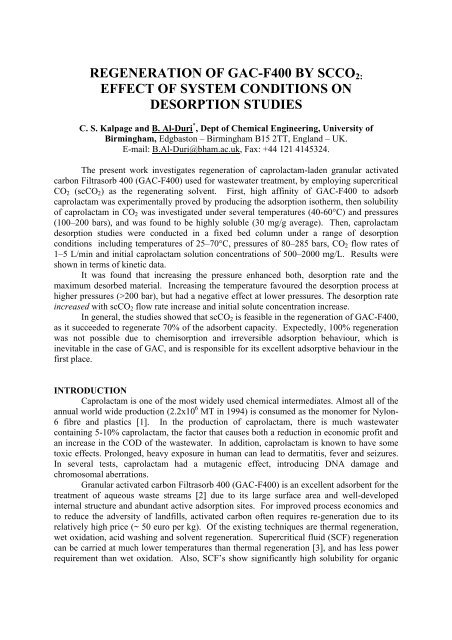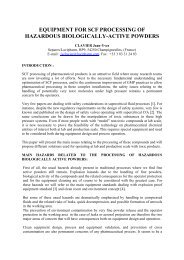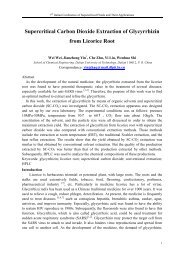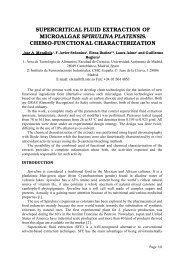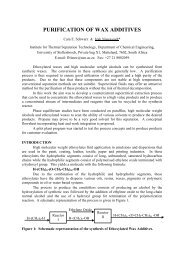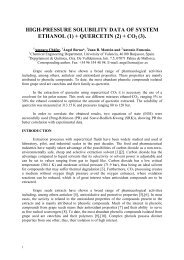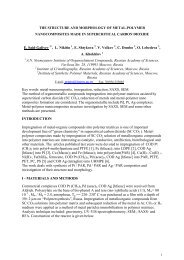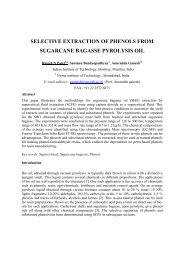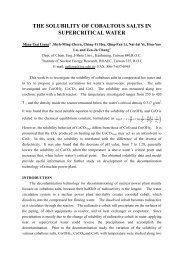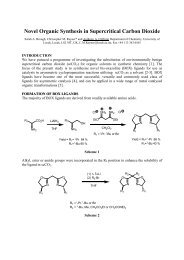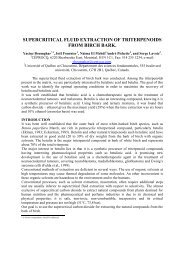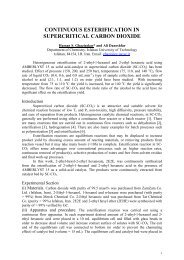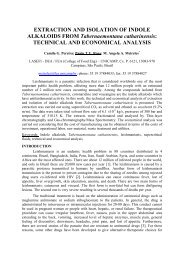REGENERATION OF GAC-F400 BY SCCO2: EFFECT OF ... - ISASF
REGENERATION OF GAC-F400 BY SCCO2: EFFECT OF ... - ISASF
REGENERATION OF GAC-F400 BY SCCO2: EFFECT OF ... - ISASF
Create successful ePaper yourself
Turn your PDF publications into a flip-book with our unique Google optimized e-Paper software.
<strong>REGENERATION</strong> <strong>OF</strong> <strong>GAC</strong>-<strong>F400</strong> <strong>BY</strong> SCCO 2:<br />
<strong>EFFECT</strong> <strong>OF</strong> SYSTEM CONDITIONS ON<br />
DESORPTION STUDIES<br />
C. S. Kalpage and B. Al-Duri * , Dept of Chemical Engineering, University of<br />
Birmingham, Edgbaston – Birmingham B15 2TT, England – UK.<br />
E-mail: B.Al-Duri@bham.ac.uk, Fax: +44 121 4145324.<br />
The present work investigates regeneration of caprolactam-laden granular activated<br />
carbon Filtrasorb 400 (<strong>GAC</strong>-<strong>F400</strong>) used for wastewater treatment, by employing supercritical<br />
CO 2 (scCO 2 ) as the regenerating solvent. First, high affinity of <strong>GAC</strong>-<strong>F400</strong> to adsorb<br />
caprolactam was experimentally proved by producing the adsorption isotherm, then solubility<br />
of caprolactam in CO 2 was investigated under several temperatures (40-60°C) and pressures<br />
(100–200 bars), and was found to be highly soluble (30 mg/g average). Then, caprolactam<br />
desorption studies were conducted in a fixed bed column under a range of desorption<br />
conditions including temperatures of 25–70°C, pressures of 80–285 bars, CO 2 flow rates of<br />
1–5 L/min and initial caprolactam solution concentrations of 500–2000 mg/L. Results were<br />
shown in terms of kinetic data.<br />
It was found that increasing the pressure enhanced both, desorption rate and the<br />
maximum desorbed material. Increasing the temperature favoured the desorption process at<br />
higher pressures (>200 bar), but had a negative effect at lower pressures. The desorption rate<br />
increased with scCO 2 flow rate increase and initial solute concentration increase.<br />
In general, the studies showed that scCO 2 is feasible in the regeneration of <strong>GAC</strong>-<strong>F400</strong>,<br />
as it succeeded to regenerate 70% of the adsorbent capacity. Expectedly, 100% regeneration<br />
was not possible due to chemisorption and irreversible adsorption behaviour, which is<br />
inevitable in the case of <strong>GAC</strong>, and is responsible for its excellent adsorptive behaviour in the<br />
first place.<br />
INTRODUCTION<br />
Caprolactam is one of the most widely used chemical intermediates. Almost all of the<br />
annual world wide production (2.2x10 6 MT in 1994) is consumed as the monomer for Nylon-<br />
6 fibre and plastics [1]. In the production of caprolactam, there is much wastewater<br />
containing 5-10% caprolactam, the factor that causes both a reduction in economic profit and<br />
an increase in the COD of the wastewater. In addition, caprolactam is known to have some<br />
toxic effects. Prolonged, heavy exposure in human can lead to dermatitis, fever and seizures.<br />
In several tests, caprolactam had a mutagenic effect, introducing DNA damage and<br />
chromosomal aberrations.<br />
Granular activated carbon Filtrasorb 400 (<strong>GAC</strong>-<strong>F400</strong>) is an excellent adsorbent for the<br />
treatment of aqueous waste streams [2] due to its large surface area and well-developed<br />
internal structure and abundant active adsorption sites. For improved process economics and<br />
to reduce the adversity of landfills, activated carbon often requires re-generation due to its<br />
relatively high price (~ 50 euro per kg). Of the existing techniques are thermal regeneration,<br />
wet oxidation, acid washing and solvent regeneration. Supercritical fluid (SCF) regeneration<br />
can be carried at much lower temperatures than thermal regeneration [3], and has less power<br />
requirement than wet oxidation. Also, SCF’s show significantly high solubility for organic
compounds and much reduced mass transfer limitations, hence they give much higher<br />
recovery in desorption, and less environmental impact than conventional solvent regeneration.<br />
MATERIALS AND METHODS<br />
Materials: Caprolactam ((C 6 H 11 ON) is the adsorbate supplied by Sigma Chemicals UK.<br />
Granular activated carbon Filtrasorb 400 is the adsorbent, supplied by Chemviron carbon, UK<br />
Ltd. CO 2 of commercial grade is the regenerant (solvent) is supplied by BOC Ltd.<br />
Preparation of system: <strong>GAC</strong> F-400 was first crushed using a rod mill and screened to a<br />
series of particle size ranges. Each fraction was repeatedly rinsed with distilled water to<br />
remove fines, dried at 110 0 C for 24 hours and stored in airtight containers. Aqueous<br />
solutions were prepared (using distilled water) and brought into contact with 3 g of activated<br />
carbon in 1L reactors and magnetically stirred overnight. The exhausted activated carbon was<br />
then filtered out and dried at 110 0 C for 24 hours. After drying, 2.5 g of prepared exhausted<br />
carbon was packed in a 0.8 cm ID stainless steel 316 tube with a height of 14 cm. The packed<br />
bed desorber was then fitted in the Test rig.<br />
The operation rig:<br />
Figure 1 is a schematic diagram of the experimental set up:<br />
1.CO 2 cylinder, 4.Freezer unit, 6.Liquid pump, 11.Co-solvent injection, 13.Heat exchange coil,<br />
14.Desorber, 16.Insulated tubing, 21.Solvent reservoir, 23.Micro metering valve, 24.Heating Tape, 25.Cold<br />
trap 26.Sampling point, 27.Rotameter, 28.Filter, 29.Dry test meter, 17.Bursting disk, 3, 8, 18 Pressure<br />
gauges, 5, 9, 19 Temperature gauges, 2, 7, 10, 12, 20, 22 Stop valves.<br />
Figure 1: A schematic diagram of the operation rig.<br />
Carbon dioxide withdrawn from the cylinder was chilled then compressed to the<br />
operating pressure, before passing through a heat exchanger coil where it was heated to the<br />
operating temperature. It then passed through the desorber unit, which are immersed in<br />
constant temperature water bath, maintaining the operating temperature within ±1 0 C. The exit<br />
from the desorber was then expanded across a micro metering valve. The flow rate in the<br />
desorber was determined by the volumetric flow rate of the expanded gas as it passed through<br />
the Rota-meter and the total flow by the Dry test meter.<br />
The desorbed caprolactam was collected in a cold trap which contained Ethanol at 0<br />
0 C. Before withdrawing a 5-ml sample from the cold trap, the flow of CO 2 was temporarily<br />
stopped by the stop valve (6), and then the expansion zone was washed with 10 ml of Ethanol<br />
from the solvent reservoir.
Samples were analysed in a GC (Varian Factor Four capillary column) coupled with a<br />
Fame Ionisation Detector. In solubility tests, the desober was packed with powder<br />
caprolactam, and CO 2 was passed for 45 minutes. Caprolactam in the expanded CO 2 was<br />
collected in a thimble filter through which the gas was released to the rotameter, wet test<br />
meter and finally to atmosphere.<br />
RESULTS AND DISCUSSION<br />
Adsorption studies: Figure 2 shows the<br />
adsorption isotherm for caprolactam on<br />
<strong>GAC</strong>-<strong>F400</strong> using 355-500µm granules.<br />
Results showed the <strong>GAC</strong>-<strong>F400</strong> capacity to<br />
be around 200 mg/g, which is high. The<br />
isotherm showed Redlich-Peterson<br />
behaviour. This indicated reversibility<br />
properties, i.e. possibility of regeneration;<br />
and heterogeneous surface behaviour,<br />
which is related to the energy of adsorption<br />
and adsorbate distribution on the <strong>GAC</strong><br />
surface.<br />
Carbon loading mg/g<br />
200<br />
150<br />
100<br />
50<br />
0<br />
0 1000 2000 3000 4000 5000<br />
Liquid phase concentration, mg/L<br />
Figure 2: Adsorption equilibrium isotherm for<br />
caprolactam /<strong>GAC</strong>-<strong>F400</strong> system, under<br />
atmospheric conditions.<br />
Solubility studies: The solubility of Caprolactam was evaluated in scCO 2 at a range of<br />
pressures and temperatures. Table 1 shows the results:<br />
Solubility of Caprolactam in scCO 2 , g/kg<br />
Temperature<br />
Pressure (bar)<br />
(º C) 100 125 150 175 200<br />
40 13.33 27.35 163.8 *<br />
50 7.52 14.09 24.13<br />
60 2.63 3.44 15.73 30.07<br />
* With a recycle flow.<br />
Table 1: Solubility of caprolactam in scCO 2 at various temperatures and pressures.<br />
Results show good solubility in scCO 2 , though values are rather low compared to<br />
literature [4]. It is clear that at lower pressures the solubility improved with temperature<br />
decrease, while the effect was reversed under higher pressures. This is related to the density<br />
of scCO 2 , and the vapour pressure of solute. This will be further discussed in the following<br />
sections.<br />
Desorption Studies:<br />
The rate of desorption: Figures 3 and 4 show the kinetic plot of desorption for temperatures<br />
25 and 40ºC, respectively at various pressures. Generally, the rate of desorption increases<br />
with pressure at both temperatures, but it is observable that the effect of pressure is more<br />
prominent for pressures and temperatures around the critical region.
Mass desorbed, mg<br />
300<br />
250<br />
200<br />
150<br />
100<br />
80 bar 100 bar 135 bar<br />
175 bar 210 bar 250 bar<br />
285 bar<br />
Mass desorbed, mg<br />
300<br />
250<br />
200<br />
150<br />
100<br />
80 bar 100 bar 135 bar<br />
175 bar 210 bar 250 bar<br />
285 bar<br />
50<br />
50<br />
0<br />
0 50 100 150 200<br />
time, min<br />
Figure 3: The effect of pressure on the<br />
supercritical desorption rate in caprolactam /<br />
<strong>GAC</strong>-<strong>F400</strong>, at 25 ºC.<br />
0<br />
0 50 100 150 200<br />
time, min<br />
Figure 4: The effect of pressure on the<br />
supercritical desorption rate in caprolactam /<br />
<strong>GAC</strong>-<strong>F400</strong>, at 40 ºC.<br />
Clearly, at 25ºC (subcritical T) the desorption rate is ‘less sensitive’ to pressure changes than<br />
at 40ºC (supercritical). Above T c (31ºC), the CO 2 density (and hence solvating power) is<br />
highly sensitive to changes in pressure the factor that is responsible for the ‘tunability’ of SCF<br />
properties in that operation region. This is shown in the ‘wide spread’ of desorption rates in<br />
Figure 3. Typically, the desorption curves are not linear with time, indicating the effect of<br />
intraparticle diffusion within the <strong>GAC</strong> particles, which is a function of time and position or<br />
location of caprolactam molecules within the <strong>GAC</strong> particles.<br />
The effect of temperature and pressure: Figures 5 and 6 show the maximum desorbed<br />
amount of caprolactam as function of pressure and temperature, respectively. For a given<br />
system, the maximum desorbed amount is a balance of two factors, namely the solvent<br />
density and the vapour pressure of the solute. At lower pressures, increasing the temperature<br />
reduces the solvent density and hence its activity (power). Higher pressures enhance the<br />
solute vapour pressure (volatility) to an extent that overcomes the reduction in solvent density<br />
inflicted by elevated temperatures. Hence the effect of temperature ‘reverses’ above a certain<br />
pressure, generally termed as the ‘crossover pressure’. Figure 4 shows that the crossover<br />
pressure is about 200 bars, below which low temperature operation is favoured, while high<br />
temperature operation is required above.<br />
250<br />
250<br />
Max desorbed, mg<br />
200<br />
150<br />
100<br />
50<br />
0<br />
25 deg C<br />
40 deg C<br />
50 deg C<br />
60 deg C<br />
70 deg C<br />
50 100 150 200 250 300<br />
Presure, bar<br />
Figure 5: The effect of pressure on the<br />
maximum mass desorbed in caprolactam /<br />
<strong>GAC</strong>- <strong>F400</strong> system at various temperatures.<br />
Mex desorbed, mg<br />
200<br />
150<br />
100<br />
50<br />
0<br />
80 bar<br />
100 bar<br />
135 bar<br />
175 bar<br />
210 bar<br />
250 bar<br />
285 bar<br />
20 40 60 80 100<br />
Temperature,C<br />
Figure 6: The effect of temperature on the<br />
maximum mass desorbed in caprolactam /<br />
<strong>GAC</strong>- <strong>F400</strong> system at various pressures.
Figure 6 shows the same effects in a slightly different fashion. The maximum amount<br />
adsorbed greatly decreased with temperature at lower pressures up to about 200 bars where<br />
the effect began to reverse and total amount desorbed increased with temperature.<br />
It is interesting to see that the same effects observed in SF extraction systems are<br />
observed in this desorption system. While extraction is a dissolution process, desorption is<br />
the breakage of solute-particle surface bonds originally formed during adsorption. While the<br />
use of SCF reduced mass transfer limitations, it would not totally eradicate them.<br />
The effect of SCF flow rate: Figure 7 shows the effect of CO 2 flow rate on the rate of<br />
desorption. It is clear that increased SCF flow increased both the rate of desorption and the<br />
maximum amount of caprolactam desorbed. At 40ºC and 250 bars and after three hours, the<br />
maximum amount desorbed was increased by 141% upon doubling the CO 2 flow from 1 to 2<br />
L/min, and by 160% upon using 5 L/min. A detailed economic assessment is required to find<br />
the optimum CO 2 flow rate.<br />
Mass desorbed, mg<br />
200<br />
150<br />
100<br />
50<br />
0<br />
1 L/min 2 L/min<br />
3 L/min 4 L/min<br />
5 L/min<br />
0 50 100 150 200 250<br />
time, min<br />
Figure 7: The effect of CO 2 flow rate on<br />
desorption of caprolactam /<strong>GAC</strong>-<strong>F400</strong> system at<br />
250 bars and 40ºC.<br />
At higher flows (> 3 L/min) the desorption<br />
rate curves became closer, as they showed<br />
a balance between two contradicting<br />
effects: higher solvent amounts in a unit<br />
time would enhance desorption, and<br />
increased solvent flow rate would reduce<br />
film mass transfer limitations, which<br />
increased desorption rate on the one hand.<br />
Whereas reduced residence time would<br />
naturally reduce the mass desorbed.<br />
The net effect is enhanced desorption rate.<br />
The effect of initial carbon loading: Figure 7 shows the effects of initial carbon loading with<br />
caprolactam on the rate of desorption using 2 L/min of CO 2 , at 250 bars and 40ºC.<br />
It shows that at a given CO 2 flow rate,<br />
desorption rate increased with the initial<br />
concentration of caprolactam, which in<br />
turn affected the <strong>GAC</strong> loading. This<br />
would naturally increase the driving force<br />
for desorption. Yet, at 500 ppm initial<br />
concentration, 81.5% of the caprolactam<br />
was desorbed, while it reduced to 70.3%<br />
for a 1000ppm solution, and remained<br />
around 69% desorption at higher<br />
concentrations (1500 and 2000 ppm). This<br />
was due to the change in the solid/fluid<br />
ratio, which affects the internal resistance<br />
in the system. Besides, in systems with<br />
higher loading, part of the caprolactam<br />
would be resident in the micropores (inner<br />
pores with smaller diameter.<br />
Mass desorbed, mg<br />
250<br />
200<br />
150<br />
100<br />
50<br />
0<br />
500 ppm 1000 ppm<br />
1500 ppm 2000 ppm<br />
0 50 100 150 200 250<br />
time, min<br />
Figure 8: The effect of initial concentration and<br />
hence the carbon loading on the rate of<br />
supercritical desorption in caprolactam / <strong>GAC</strong>-<br />
<strong>F400</strong> system, at 250 bars and 40ºC.
In the micropores, the pore diameters would be of comparable sizes to the adsorbate<br />
molecular diameter, hence the adsorption mechanism is based on multidimentional<br />
interactions [5] forming bonds that are much harder to break, the factor that is<br />
responsible for irreversible adsorption no matter how powerful the regenerating solvent.<br />
Table 2 below shows the initial carbon loadings based on the caprolactam solutions that they<br />
were prepared from:<br />
Initial solution<br />
concentration, ppm<br />
Initial <strong>GAC</strong>-<strong>F400</strong><br />
loading, mg<br />
Mass desorbed , mg % desorbed in the<br />
run<br />
500 193 157 82.5<br />
1000 288 202 70.3<br />
1500 325 224 69.05<br />
2000 536 244 68.9<br />
Table 2: Carbon loadings and mass of caprolactam desorbed, which are correspondent to various initial<br />
solution concentrations.<br />
CONCLUSIONS<br />
The present work has led to the following conclusions:<br />
• Supercritical CO 2 can be successfully used to regenerate <strong>GAC</strong>-<strong>F400</strong>, originally used<br />
to remove caprolactam from aqueous waste streams, by recovering up to 70% of the<br />
caprolactam. The latter can be recovered if required, to 100% purity.<br />
• Both the rate of desorption and maximum amount desorbed favoured higher operating<br />
pressures (= 200 bars).<br />
• The optimum desorption temperature is 25ºC for pressures = 200 bars, and 40ºC for<br />
pressures > 200 bars.<br />
• The rate of desorption increases with the solvent (regenerant) flowrate and initial<br />
solute concentration in the effluent stream.<br />
• Complete economic assessment of the process is required before selecting the<br />
optimum overall operating conditions.<br />
REFERENCES<br />
[1] HE, C-H, GAO, Y-H, YANG, S-H & EDWARDS, D.W., J. Loss Prev. Proc. Ind., vol. 17,<br />
2004, 195.<br />
[2] AL-DURI, B. PhD thesis, the Queen’s University of Belfast, 1988.<br />
[3] TOMASKO, D.L., HAY, K.L., LEMAN, G.L., ECKERT, C.A., Fluid. Env. Prog., vol.12<br />
(3), 1993, 208.<br />
[4] ANTERO,L & MATTI, J., J. Chem. Eng. Data, vol. 41, 1996, 1418.<br />
[5] YANG, X.Y. & AL-DURI, B., Chem. Eng. J., vol 83, 2001, 15.


